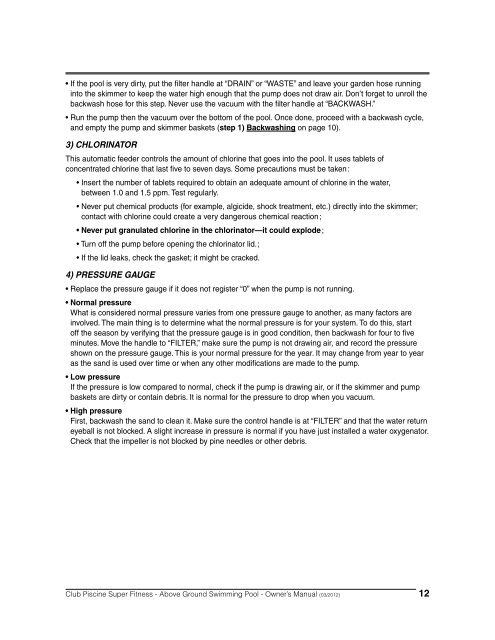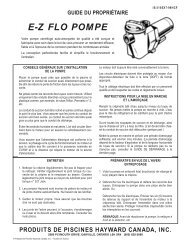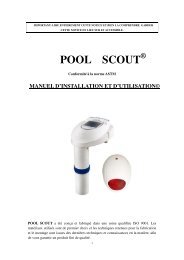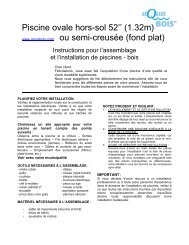Download the above ground pool manual - Club Piscine
Download the above ground pool manual - Club Piscine
Download the above ground pool manual - Club Piscine
You also want an ePaper? Increase the reach of your titles
YUMPU automatically turns print PDFs into web optimized ePapers that Google loves.
• If <strong>the</strong> <strong>pool</strong> is very dirty, put <strong>the</strong> filter handle at “DRAIN” or “WASTE” and leave your garden hose running<br />
into <strong>the</strong> skimmer to keep <strong>the</strong> water high enough that <strong>the</strong> pump does not draw air. Don’t forget to unroll <strong>the</strong><br />
backwash hose for this step. Never use <strong>the</strong> vacuum with <strong>the</strong> filter handle at “BACKWASH.”<br />
• Run <strong>the</strong> pump <strong>the</strong>n <strong>the</strong> vacuum over <strong>the</strong> bottom of <strong>the</strong> <strong>pool</strong>. Once done, proceed with a backwash cycle,<br />
and empty <strong>the</strong> pump and skimmer baskets (step 1) backwashing on page 10).<br />
3) CHloRInAToR<br />
This automatic feeder controls <strong>the</strong> amount of chlorine that goes into <strong>the</strong> <strong>pool</strong>. It uses tablets of<br />
concentrated chlorine that last five to seven days. Some precautions must be taken :<br />
• Insert <strong>the</strong> number of tablets required to obtain an adequate amount of chlorine in <strong>the</strong> water,<br />
between 1.0 and 1.5 ppm. Test regularly.<br />
• Never put chemical products (for example, algicide, shock treatment, etc.) directly into <strong>the</strong> skimmer;<br />
contact with chlorine could create a very dangerous chemical reaction ;<br />
• Never put granulated chlorine in <strong>the</strong> chlorinator—it could explode ;<br />
• Turn off <strong>the</strong> pump before opening <strong>the</strong> chlorinator lid.;<br />
• If <strong>the</strong> lid leaks, check <strong>the</strong> gasket; it might be cracked.<br />
4) PReSSURe GAUGe<br />
• Replace <strong>the</strong> pressure gauge if it does not register “0” when <strong>the</strong> pump is not running.<br />
• Normal pressure<br />
What is considered normal pressure varies from one pressure gauge to ano<strong>the</strong>r, as many factors are<br />
involved. The main thing is to determine what <strong>the</strong> normal pressure is for your system. To do this, start<br />
off <strong>the</strong> season by verifying that <strong>the</strong> pressure gauge is in good condition, <strong>the</strong>n backwash for four to five<br />
minutes. Move <strong>the</strong> handle to “FILTER,” make sure <strong>the</strong> pump is not drawing air, and record <strong>the</strong> pressure<br />
shown on <strong>the</strong> pressure gauge. This is your normal pressure for <strong>the</strong> year. It may change from year to year<br />
as <strong>the</strong> sand is used over time or when any o<strong>the</strong>r modifications are made to <strong>the</strong> pump.<br />
• Low pressure<br />
If <strong>the</strong> pressure is low compared to normal, check if <strong>the</strong> pump is drawing air, or if <strong>the</strong> skimmer and pump<br />
baskets are dirty or contain debris. It is normal for <strong>the</strong> pressure to drop when you vacuum.<br />
• High pressure<br />
First, backwash <strong>the</strong> sand to clean it. Make sure <strong>the</strong> control handle is at “FILTER” and that <strong>the</strong> water return<br />
eyeball is not blocked. A slight increase in pressure is normal if you have just installed a water oxygenator.<br />
Check that <strong>the</strong> impeller is not blocked by pine needles or o<strong>the</strong>r debris.<br />
<strong>Club</strong> <strong>Piscine</strong> Super Fitness - Above Ground Swimming Pool - Owner’s Manual (03/2012) 12










